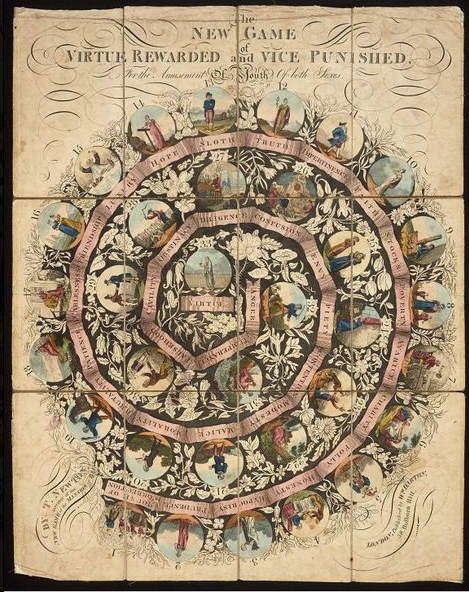Virtue Board Games
I never knew that "Snakes and Ladders" belonged to this category.
Read an excellent short history here.
One example, with description taken from this other site:

Read an excellent short history here.
One example, with description taken from this other site:

A frankly insane 19th century board game.
The game comes on a series of hand painted paper tiles attached to a thin cloth allowing it to be folded up and put into a drawstring case. When unfolded, it forms a spiral-shaped track on the board going from the outside and running anti-clockwise to the centre. Included are some things to use as counters and a spinner, through which a matchstick can be pushed to form a single-dimensional-rotary d4 equivalent. This is intentional by the makers as they did not want to be seen to be encouraging customers to bring a dice box into private homes. Yes, that is the stated reason as given in the rules to this game, which is described as "for the Amusement of Youth of both Sexes."
Also included are a number of tokens which are handed out to players as they play. Players start at the beginning (i.e. before space 1), roll the dice spin the spinner, which yields a value from 1 to 4 (were d4s available in 1818?), and move that number of spaces. Each space is named with either a Virtue or a Vice and every single one has an effect, usually relating to the rewards that such a virtue might bring (i.e. receiving tokens), or the comeuppance of "the dangerous paths of Vice" which do bad things to the player. Apart from "Hope" which requires the player to "wait with patience until the next turn."
So the players spin, move, and things happen to them, much like the Game of the Goose. It's quite clear from reading the rules, however, that the moral behind the game is highly flawed. Many of the Virtue spaces reward you with "tokens" yet these tokens have zero bearing on the outcome of the game. It is mentioned that the first player to land on the final space (with the whole if you overshoot you must count back rule in effect) "claims the contents of the bank and wins the game" yet there is no indication of what the tokens are for. The first player to the final space, imaginatively named "Virtue," wins regardless of how many tokens everyone has. This means that you could have systematically landed on every vice space imaginable but if you're first to land on the final space exactly, you win regardless of the number of tokens in the bank. The rules also don't specify how many tokens should go in the bank and with the preponderance of "vice" spaces that send you back often a long way, i.e. to "House of Correction" (space 1) or "Stocks" (space 9) a player skilled in fudging spinner spins could well find themselves with an infinite number of tokens. So even if you insert the house rule that the player with the most tokens wins, the player getting to the end "claims the contents of the bank" and therefore has infinity tokens and wins that way.
So what's the real moral message imparted by this game? That stopping to help and be charitable and nice is all well and good but the victory in life goes to whoever barges through the fastest or to the luckiest player. The attempt at inculcating a set of moral values into the youth of both sexes is undermined by the fact that players don't have to make any active choice; at the end of the day, whoever spins the lucky numbers gets the prize at the end of the day.
I can't help but feel that this kid of explains something about Victorian morality though I can't think what.
Comments
Commenting is not available in this channel entry.

Category: Games | Nineteenth Century | Twentieth Century | Ethics and Morals